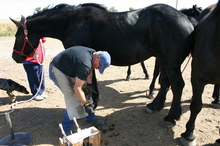A horseâs hooves grow all year long, but growth slows as cooler weather approaches, dropping from an average of about a quarter-inch per month to half that rate in the winter.

Importance of year-round hoof care for your horse
Regardless of whether theyâre shod or not, all horses should have their hooves picked out and inspected daily, and should be trimmed on a regular basis year-around.
Owners might think they do not need to call the farrier as often during the winter, but regular hoof care is just as important during this season. Keeping the hooves trimmed and balanced will help prevent chipping and cracking, and a four- to six-week schedule will allow the hoof and pastern structures to stay at correct angles.
In the winter, farriers check for hoof bruises and abscesses caused by walking or running on rough, frozen ground. A horse with a serious sole bruise or abscess is usually visibly lame.
Horses with minor hoof bruises usually only require time off of work, but a farrier or veterinarian will often need to treat an abscess by first locating the painful area and then cutting into the sole to relieve pressure and allowing pus to drain out. A shoe with a pad can be used to keep dirt away from the sole until the abscess heals.
Mud is a fact of life on most farms during the winter, and standing or walking in muddy areas can soften hooves by allowing them to absorb too much moisture. Farm managers may be able to alleviate mud to some extent.
Steps to minimize muddy conditions include placing hay in different areas of the pasture, adding raised pads of fine gravel around water troughs, and installing permeable geofabric in high-traffic areas such as gates.
The decision to leave horses shod or barefoot through the winter can be made based on what the horse will be asked to do during the season. Performance horses that are given a training break may not need shoes, while horses that are kept in work or that have therapeutic shoes will probably stay shod through the winter.
Regardless of whether theyâre shod or not, all horses should have their hooves picked out and inspected daily, and should be trimmed on a regular basis year-around.
Add a research-proven hoof supplement to your horseâs diet to support the growth of healthy, strong hoof. Use Bio-Bloom⢠PS to promote and maintain healthy hooves from the inside-out and to aid in the development of strong hoof wall, especially through the harsh elements of winter.
Kentucky Equine Research (KER) is an international equine nutrition, research and consultation company serving both the horse producer and the feed industry. Its goal is to advance the industry's knowledge of equine nutrition and exercise physiology and apply this knowledge to produce healthier, more athletic horses. For more information, see www.ker.com or call 888-873-1988.
